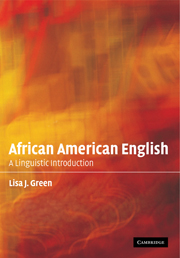Book contents
- Frontmatter
- Contents
- Foreword by John R. Rickford
- Preface
- Introduction
- 1 Lexicons and meaning
- 2 Syntax part 1: verbal markers in AAE
- 3 Syntax part 2: syntactic and morphosyntactic properties in AAE
- 4 Phonology of AAE
- 5 Speech events and rules of interaction in AAE
- 6 AAE in literature
- 7 AAE in the media
- 8 Approaches, attitudes and education
- Endnotes
- References
- Acknowledgments
- Index
8 - Approaches, attitudes and education
Published online by Cambridge University Press: 05 June 2012
- Frontmatter
- Contents
- Foreword by John R. Rickford
- Preface
- Introduction
- 1 Lexicons and meaning
- 2 Syntax part 1: verbal markers in AAE
- 3 Syntax part 2: syntactic and morphosyntactic properties in AAE
- 4 Phonology of AAE
- 5 Speech events and rules of interaction in AAE
- 6 AAE in literature
- 7 AAE in the media
- 8 Approaches, attitudes and education
- Endnotes
- References
- Acknowledgments
- Index
Summary
Focal point In preceding chapters, general descriptions of constructions in the syntactic and phonological components of AAE were presented. These descriptions may have practical applications if they can be extended to the development of classroom strategies that are used in teaching mainstream English proficiency. Using linguistic descriptions of AAE to develop lessons does not in any way mean teaching AAE to school age children. Such descriptions are useful in substantiating the claim that AAE is rule-governed, but they are not always successful in combating negative attitudes toward the linguistic system. For example, questions about whether it is right or wrong to use markers such as aspectual be or resultant state dәn usually do not just make reference to right or wrong grammatical structure. The evaluations are connected to broader social issues, as the following passage by Walter Mercer suggests.
Regardless of the “genuineness” of the dialect, regardless of how remarkably it may add flavor and soul to a poem or song or novel, regardless of the solidarity it may lend to a political rally, I say it is illogical, nonsensical, and harmful to teach an innocent black child that it's quite all right to say ‘I done gone to school.’
[Walter Mercer, from Brasch 1981]- Type
- Chapter
- Information
- African American EnglishA Linguistic Introduction, pp. 216 - 244Publisher: Cambridge University PressPrint publication year: 2002



